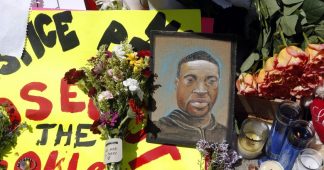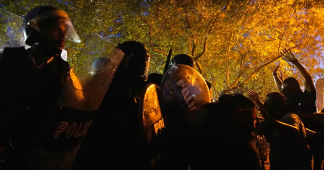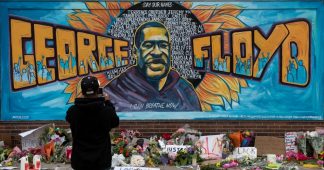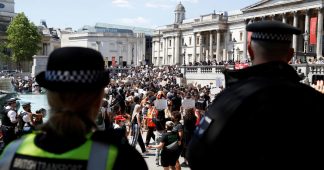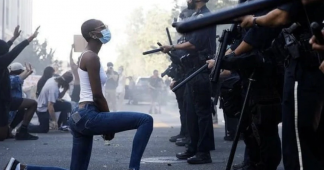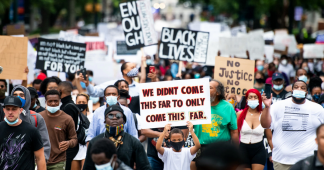A Class Rebellion: Keeanga-Yamahtta Taylor on How Racism & Racial Terrorism Fueled Nationwide Anger
June 01, 2020
In the largest nationwide uprising since the 1960s, protesters shut down cities across the United States over the weekend following the police killing of George Floyd, an African American man in Minneapolis. “These are not just repeats of past events,” says scholar Keeanga-Yamahtta Taylor. “These are the consequences of the failures of this government and the political establishment … to resolve these crises.”
Transcript
AMY GOODMAN: This is Democracy Now!, democracynow.org, The Quarantine Report. I’m Amy Goodman in New York City, joined by my co-host Nermeen Shaikh from her home also here in New York City. Hi, Nermeen.
NERMEEN SHAIKH: Good morning, Amy. And welcome to our listeners and viewers around the country and around the world.
AMY GOODMAN: Well, in the largest nationwide uprising since the 1960s, protesters shut down cities across the United States over the weekend following the police killing of George Floyd, the 46-year-old African American man in Minneapolis.
PROTESTERS: George Floyd! Say his name! George Floyd! Say his name! George Floyd! Say his name! George Floyd!
What do we want? Justice! When do we want it? Now! What do we want? Justice! When do we want it? Now! If we don’t get it? Shut it down! If we don’t get it? Shut it down! If we don’t get it? Shut it down! What do we want? Justice!
AMY GOODMAN: George Floyd died one week ago, on Memorial Day, when Minneapolis police officer Derek Chauvin arrested him and pressed his knee into Floyd’s neck for nearly nine minutes as Floyd repeatedly gasped, “I can’t breathe,” and then stopped moving. On Friday, Chauvin was charged with third-degree murder and second-degree manslaughter. The three other officers involved have been fired along with Chauvin but not arrested. Minnesota Governor Tim Walz has announced Attorney General Keith Ellison will take the lead in the investigation and any prosecutions related to George Floyd’s killing. At the Minneapolis intersection where Floyd was killed, people created a memorial and declared it a sacred space.
Meanwhile, protests continued throughout the weekend from coast to coast. The police erupted in violence in response to the widespread protests, arresting more than 4,000 people and attacking demonstrators with tear gas and rubber bullets in cities across the country. Police cars and buildings went up in flames as thousands braved the coronavirus and increasing police violence to demonstrate. In New York City alone, authorities said 47 police vehicles have been damaged. At least 40 cities have imposed curfews. The National Guard has been deployed in Minnesota, California, Illinois, Florida and other states. Police departments are facing increasing criticism for using excessive force on protesters and, in at least 50 separate incidents, attacking journalists.
The protests come as the nation’s dealing with its largest public health crisis in generations and the highest unemployment rate since the Great Depression. During protests Friday, President Trump was moved to the White House’s underground bunker. On Saturday, he took to Twitter to threaten protesters with “vicious dogs” and “ominous weapons.” He also tweeted he would designate antifa as a terrorist organization, even though legal experts say he lacks the authority to designate a domestic group as a terrorist organization, and warn such a move would violate the First Amendment.
Outrage over Floyd’s death comes after protests led to the arrest of two white men last month for the February shooting death of Black jogger Ahmaud Arbery in Georgia, and then a third man arrested, and after the Louisville police shooting death of Breonna Taylor in her home in March, which the FBI is now investigating.
The demonstrations have been mostly outside, with many people wearing masks, so it’s unclear if they’ll trigger spread of the coronavirus. But many protesters who were arrested were taken to jails that are COVID hot spots.
For more, we’re hosting a roundtable discussion with Dr. Cornel West, professor of the practice of public philosophy at Harvard University, author of many books, including Race Matters and Black Prophetic Fire. And we’re joined by Keeanga-Yamahtta Taylor, assistant professor of African American studies at Princeton University. Her recent piece for The New York Times is headlined “Of Course There Are Protests. The State Is Failing Black People.” She’s also author of Race for Profit: How Banks and the Real Estate Industry Undermined Black Homeownership and From #BlackLivesMatter to Black Liberation. And with us from Charlotte, North Carolina, Bakari Sellers is with us, an attorney and author of his new memoir, My Vanishing Country. He became the youngest African American elected official in the country when he was elected to the South Carolina state Legislature in 2006.
We welcome you all to Democracy Now! We’re going to begin with professor Keeanga-Yamahtta Taylor. If you can respond to the mass uprising that has happened around the country and the police response to it, as well as the original horror on Memorial Day, the killing of George Floyd?
KEEANGA–YAMAHTTA TAYLOR: Well, thank you, Amy, for letting me come on this morning to talk.
You know, I think part of what we are seeing is years and years of pent-up rage. Many people have referenced the 1960s, have referenced Ferguson in 2014, but I think it’s important to say that these are not just repeats of past events. These are the consequences of the failures of this government and the political establishment, the economic establishment of this country to resolve those crises, and so they build and accumulate over time. And we are watching the boiling over of that.
Imagine how angry, desperate, rage-filled you would have to be to come out and protest in the conditions of a historical pandemic that has already killed over 103,000 Americans, that has had a disproportionately horrendous impact in Black communities. I believe 23,000 or 24,000 Black people have died. To put it more bluntly, one in every 2,000 African Americans in the United States has died as the result of COVID. So imagine how difficult things have to be for people to come out in those conditions. So, I think that the buildup around police brutality, the continuation of police brutality, police abuse and violence and murder has compelled people to have to endure those conditions, because it is obvious that there is either nothing that our government can do about this or that the government is complicit and chooses not to do anything about this.
And I think that we have to add to that the crisis that is unfolding beyond police brutality in the country, as well, because we all know that the videotapes of police beatings, abuse, murder have never stopped. So, the movement that grew out of the Ferguson uprising, that became Black Lives Matter, the conditions that led to that never actually ended. And I think that what has reignited that is obviously the public lynching of George Floyd one week ago in Minneapolis, but also the conditions, the wider context within which that is spilling over. And because of that wider condition of mass unemployment, of the death that has been caused by the pandemic, that this is not just — I don’t believe these are just protests around or against police brutality.
But we see a lot of — hundreds, if not thousands, of young white people in these uprisings, making these multiracial rebellions, really. And I think that that is important. Some people have sort of described the participation of white people as outside agitators, or I know that there are reports of white supremacists infiltrating some of the demonstrations. And I think that those are things that we have to pay attention to, keep track of and try to understand. But I think we cannot dismiss in a widespread way the participation of young white people, because we have to see that what has happened over the last decade has gutted their lives, too. And there has been some discussion about this with perhaps their parents’ generation, with the description of deaths by despair.
So, we know that the life expectancy of ordinary white men and women has gone into reverse — something, by the way, that does not typically happen in the developed world. And it is driven by opioid addiction, alcoholism and suicide. And so, this generation, whose lives really — you know, if you’ve graduated from college, your life has been bracketed by war at the turn of the 21st century, by recession and now by a deadly pandemic. And so, I think we’re seeing the convergence of a class rebellion with racism and racial terrorism at the center of it. And in many ways, we are in uncharted territory in the United States.
